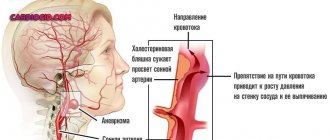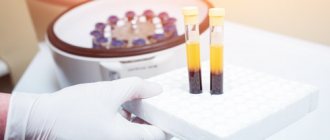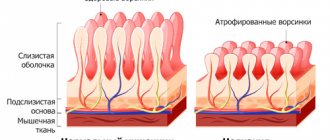Thrombin time. What is this?
Thrombin time is the time of the last stage of blood coagulation - the formation of active fibrin protein from inactive fibrinogen under the influence of thrombin protein, that is, this is the time required for the formation of a fibrin clot when thrombin is added to the plasma - an enzyme (factor IIa), which appears as a result of the interaction of factors blood clotting when a vessel is damaged.
Material for analysis:
deoxygenated blood
Thrombin molecule
Thrombin time depends on the level of fibrinogen in the blood : a decrease in the level of fibrinogen increases thrombin time, so the analysis of thrombin time is usually combined with the analysis of fibrinogen and other coagulogram .
Thrombin is necessary for the final stage of the coagulation cascade - the transformation of the fibrinogen molecule into insoluble fibrin, which is able to polymerize and form a stable fibrin clot, which stops bleeding when small and medium-sized vessels are damaged and contains, in addition to fibrin polymers, cellular elements - platelets and erythrocytes.
Qualitative or quantitative changes in fibrinogen lead to insufficient/excessive fibrin production, which is manifested by increased bleeding or a tendency to thrombosis. In laboratory conditions, the final stage of the coagulation cascade is reproduced by adding ready-made thrombin to plasma, and changes in the structure or concentration of fibrinogen are reflected in an increase or decrease in thrombin time.
Fibrinogen is a glycoprotein secreted by hepatocytes (liver cells) into the blood. In addition to being a blood clotting factor (factor I), it also provides some reactions of fibrinolysis, the process of dissolving blood clots, binds excess thrombin (therefore fibrinogen is also called antithrombin I) and activates plasminogen. In this regard, diseases with changes in the structure or concentration of fibrinogen can manifest themselves as bleeding, thrombosis, and in some cases a combination of both.
Pathologies associated with fibrinogen
Pathologies that are accompanied by fibrinogen deficiency are called hypo- and afibrinogenemia , and in which the structure and function of fibrinogen is impaired - disfibrinogenemia . They can be:
- hereditary or
- acquired.
Acquired diseases include liver disease, disseminated intravascular coagulation (DIC), primary fibrinolysis, and drug-induced reactions (eg, thrombolytic agents and L-asparaginase).
The most common cause of acquired dysfibrinogenemia is liver disease. In cirrhosis, chronic active hepatitis, acute liver failure, obstructive liver disease and hepatoma, too much sialic acid is added to the secreted fibrinogen. This modified fibrinogen has a greater negative charge, which prevents the polymerization of fibrin molecules. Patients with liver disease have multiple coagulation disorders that manifest as increased bleeding. Determination of thrombin time is the main screening test to suspect dysfibrinogenemia as one of the causes of bleeding. Abnormal fibrinogen is also produced by some tumors (some forms of squamous cell carcinoma of the cervix, adenocarcinoma of the breast, hypernephroma, hepatoma). In certain diseases accompanied by the synthesis of antibodies that interact with fibrinogen (systemic lupus erythematosus, multiple myeloma), its activity decreases, which is manifested by an increase in thrombin time.
The most common cause of acquired hypofibrinogenemia is DIC syndrome, a systemic thrombohemorrhagic disorder in which excessive formation of fibrin microthrombi and consumption of blood coagulation factors and platelets occurs. DIC always develops secondarily as a complication of any disease. There are acute and chronic DIC syndrome. The causes of acute DIC are infectious diseases (E. coli - sepsis, HIV, cytomegalovirus infection, malaria), acute myeloblastic leukemia, complications of pregnancy and childbirth (premature placental abruption, eclampsia, amniotic fluid embolism), extensive burns, massive blood transfusions and others . Causes of chronic DIC syndrome: solid tumors, chronic leukemia, pregnancy complications (intrauterine fetal death), myeloproliferative diseases, rheumatoid arthritis and Raynaud's disease, myocardial infarction, nonspecific ulcerative colitis and Crohn's disease, etc. “Triggers” the development of DIC syndrome in all In the listed conditions, a large amount of thromboplastin (tissue factor, factor III) enters the blood. At the same time, multiple microthrombi are formed in the vessels of the kidneys, brain, liver, and lungs, which determine the clinical picture of the syndrome in the form of multiple organ failure. As a result of massive consumption of fibrinogen and other blood coagulation factors, their secondary insufficiency develops and hypercoagulation is replaced by hypocoagulation and disseminated bleeding. It should be noted that hypercoagulation and hypocoagulation are often present simultaneously in the same patient, so the identification of successive periods of DIC is very arbitrary. The peculiarities of the clinical picture of DIC syndrome lead to the fact that the diagnosis of this condition remains one of the most difficult tasks of modern medicine. In this situation, monitoring thrombin time in combination with other laboratory tests is necessary to assess the risk and early diagnosis of DIC, as well as at the stage of monitoring its treatment.
Why is thrombin time lower than normal?
There are many reasons that cause a decrease in the indicator. Certain physiological conditions and the intake of certain foods affect the time it takes for a clot to form. Consumption of excess amounts of cholesterol and fatty foods leads to an increase in total cholesterol in the blood.
This condition is often observed in older men and is one of the risk factors for atherosclerosis. This disease is characterized by excessive plaque formation in the blood vessels. Severe narrowing of the lumen of blood vessels leads to hypoxia, and subsequently to tissue necrosis.
The physiological norm is considered to be thrombin time below normal during pregnancy, especially in the 3rd trimester. In some cases, infectious diseases in the acute stage shorten the time of plaque formation in a damaged vessel. The most common causes of increased time for clot formation are burns and severe allergic reactions (anaphylactic shock).
Correct interpretation of coagulogram
A coagulogram is an extensive blood test, so there are a lot of indicators in the end. They are assessed both individually and together. An extensive online table of indicators clearly shows the state of the body and the percentage of substances in the blood.
Clotting time is the interval between the onset of bleeding and its cessation.
Normally, capillary blood thickens up to 5 minutes, and venous blood from 5 to 10 minutes. Poor blood clotting can be a consequence of liver disease, vitamin C intake, hemophilia, etc. Hormonal medications can reduce clotting time.
Coagulogram parameters:
- PTI (prothrombin index) - shows the ratio of the normal blood clotting time to the patient’s result. The norm in this case is from 97 to 100%. Pregnant women can have a rate of up to 150%. This figure may increase while taking hormones. PTI helps to find problems in the liver, thrombosis. Regular intake of vitamin K every day will help keep this indicator normal.
- APTT (activated partial thromboplastin time) or APTT refers to the rate of blood clotting. The normal indicator ranges from 30 to 40 seconds.
- AVR – normally this indicator ranges from 51 to 70 seconds. If the AVR is low, it may be a sign of high bleeding, and if it is increased, then it is a sign of thrombocytopenia, severe injuries, and burns.
- GRP is an index showing the coagulation time of citrate whey using calcium salts. The norm in this case is 1-2 minutes.
- The fibrinogen level is from 2 to 4 g/l. The synthesis of the substance occurs in the liver and turns into fibrin, which in turn can cause the formation of blood clots. The indicator may change in pregnant women, people who have undergone surgery and infections. Fibrinogen B is not present in healthy people.
- The RFMC indicator indicates changes in fibrin during coagulation. The norm is 4 mg per 100 ml.
- Fibrinolytic activity is an index that shows how well the blood dissolves blood clots. This is what fibrinolysin is responsible for. The concentration of this substance shows the level of blood clotting. Thrombotest is normal grade 4-5.
- The ratio of plasma to heparin shows the formation of a fibrin clot (dimer) after the addition of heparin to it. The norm is 7-15 minutes. This analysis indicates liver damage, pathologies of the heart and blood vessels, and the presence of tumors.
Normal blood clot retraction ranges from 45% to 65%. An increase in indicators can be noted with anemia, thrombocypotenia, erythrocytosis. Duke bleeding duration is a special test during which blood is taken from a finger prick for analysis. During this, the blood from the capillary is blotted several times, which allows you to measure the time until the next drop appears. This study helps to understand the speed of blood clotting.
Treatment of abnormalities
A blood test for thrombin time is one of the basic tests for assessing the hemostatic system. It characterizes the final stage of the coagulation process, at which fibrinogen is converted into insoluble fibrin. The results are used in hematology, anesthesiology, resuscitation, surgery, obstetrics and gynecology, and hepatology.
Treatment is prescribed by a doctor of the appropriate specialty after receiving data from a comprehensive examination and establishing a diagnosis. Often, the magnitude of the deviation of indicators from the norm correlates with the severity and severity of the pathological process. Minor fluctuations in values relative to the reference values can be eliminated by properly preparing for the blood sampling procedure: eliminating smoking, physical activity and stress, and discussing with your doctor the need and possibility of discontinuing medications taken.
Prothrombin norms in different groups of patients
The levels of this glycoprotein in the blood vary somewhat among different age groups. In children under 18 years of age, its normal content ranges from 80 to 110%, in adults – from 78 to 145%.
The norms for adult men and women are no different. A moderate increase in prothrombin may occur in women before childbirth.
This indicator is determined in all coagulograms. What does prothrombin index mean?
The normal prothrombin index is 80-105%. The greater the patient’s PV compared to normal, the lower his PI will be and vice versa. Accordingly, a low index indicates poor coagulability, and a high index indicates hypercoagulation (propensity for thrombosis).
The prothrombin index test is prescribed in the same situations as the Quick prothrombin test. Basically, both of these values are in direct correlation and in the range of normal content can be the same.
The norm of the prothrombin index during pregnancy differs slightly by trimester:
- I trimester – 80-119%
- II – 85-120%
- III – 90-130%.
Thrombin time - normal, increase and decrease in the index, causes and symptoms
Blood is the liquid medium of the human body that transports vital elements: oxygen, carbon dioxide, proteins, lipids, carbohydrates. Blood elements perform a protective function, preventing excessive bleeding during injuries.
Attention! The composition of blood includes anucleate, lamellar and white blood cells. Platelets are cells of the hemostatic system involved in the occlusion of damaged vessels. To determine the parameters of hemostasis (blood clotting), a coagulogram is prescribed.
How the analysis is carried out: requirements before passing, progress and interpretation of the results
Preparation for donating blood includes a standard set of rules:
- Do not have breakfast on the day of the test. The previous meal is allowed no earlier than 8–9 hours before the visit to the clinic.
- drinking is allowed, but only clean water;
- per day, fatty, spicy and salty foods, as well as alcohol, are excluded from the diet;
- one hour before the test you should not smoke;
- You should stop taking medications within two days, especially those that affect blood composition. If it is impossible to refuse some medications for health reasons, you must inform your doctor in advance.
Blood is drawn from a vein located under the skin of the inner surface of the elbow.
Lab workers stabilize the sample by adding sodium citrate to a tube, then put the blood in a centrifuge to separate out the plasma. By adding different reagents to it, the laboratory assistant monitors the changes and records them in the analysis form.
General information
As part of the coagulogram, a study of thrombin time is carried out, which characterizes the last stage of blood coagulation - the conversion of fibrinogen (a protein in a blood clot) into fibrin (the basis of a blood clot) as a result of the reaction of blood with thrombin and calcium.
- Thrombin time
- General information
- Indications
- Thrombin time is normal
- Increasing values (extending interval)
- Decreased values (reduced thrombin time)
- Study of thrombin time in pregnant women and children
- Diagnosis by symptoms
- Thrombin time norm, reasons for increase or decrease of this indicator in tests
- What is thrombin time?
- How is the procedure for collecting blood for testing performed?
- Thrombin time: normal
- Why is thrombin time elevated?
- Why is thrombin time lower than normal?
- Let's understand what thrombin time is?
- Preparing for analysis
- Normal value and deviations in indicators
- Principle of the method
- Add a comment Cancel reply
- Thrombin time: concept, analysis and norm, increase and decrease
- Thrombin time is among the basic indicators of a coagulogram
- Does the plasma not clot or does the clot form very quickly?
- What is thrombin time: normal, causes of deviations, values during pregnancy
- Definition
- When is the analysis performed?
- Preparing for analysis
- Interpretation of the data obtained
- Reasons for deviations
- What are the meanings during pregnancy?
- Thrombin time - normal indicators, reasons for deviations from the norm
- Why does thrombin time change?
- Thrombin time: What is it? Normal Increase
Why do they donate and what is a blood coagulogram?
Why do they take a coagulogram? There are several indications for taking this test, these are the following reasons - the need for a general assessment of blood circulation, examination of the patient before surgery.
And further:
- Childbirth or cesarean
- When planning a child,
- Normocoagulation,
- Various gestoses of varying severity,
- Monitoring treatment with blood thinning drugs
- Detection of blood diseases, such as hemophilia,
- Presence of varicose veins,
- The likelihood of thrombosis,
- Presence of heart and vascular diseases,
- Definition of DIC syndrome,
- Taking birth control pills
- Chronic liver diseases,
- The presence of inflammation and infections in the patient,
- Detection of thrombosis in various arteries, detection of stroke.
For pregnant women, this analysis allows them to find out if they have uterine diseases or gestosis disorders. This test is also prescribed for women who have previously had miscarriages. Ordinary people need this blood test to identify certain diseases.
Blood for coagulogram - what kind of analysis is it (video)
In general, it can be noted that a coagulogram is an important test; at least 750 million people around the world take it every year. This study makes it possible to understand whether a person can undergo surgery without losing a lot of blood, and also to identify diseases of the liver, immune system, heart and blood vessels. Pregnant women and people who have chronic diseases related to blood functioning are required to undergo this test. The price of such a study is quite high, but it allows an objective and broad examination of the patient’s hemostasis.
Prothrombin according to Quick
The test is also based on the ratio of the patient's normal prothrombin time to the patient's PT, expressed as a percentage. But the method is considered more accurate. For the study, several dilutions of plasma are used (1:2, 1:3,1:4) and the construction of a calibration graph. For each dilution, the PT is determined and marked on the graph.
Prothrombin rates according to Quick are from 75% to 140%.
Within the normal protein content, the Kwik and PTI results may be identical. At low contents, these indicators sometimes diverge.
This index is indicated on each package of the reagent. INR allows standardization of the results of PT and IPT performed in different laboratories. The INR value in healthy individuals is 0.8-1.2.
The numbers of prothrombin according to Quick and INR are inversely proportional to each other: if prothrombin according to Quick is increased, then the INR is reduced and vice versa.












